The Returned & Services League of Australia (RSL Australia) was formed in 1916 in response to the lack of a unified approach to the organization of repatriation facilities and medical services for those returning from the Great War (World War I) and to provide returning Servicemen with the mate ship and concern for each other, which was such a part of life in war.
In 1917 The Gippsland Independent, Buln Buln, Warragul, Berwick, Poowong & Jeetho Shire Advocate reported that:
A public meeting took place in the Mechanics Institute of Longwarry in March 1917 to discuss the welcoming home of returning soldiers to the District. Pte G Bissett had returned, invalided from war injuries. It was suggested that a local committee be formed to give him and all other returning soldiers a public reception and also honor those who would never return. It was moved that the league be formed and named “The Longwarry Soldiers Memorial League”. An entrance fee and a yearly subscription was proposed. At this stage the town was pledged to build a monument to the fallen from the district and a site had been chosen near the railway crossing. With a subscription having been agreed to join the league, funds from these (subs) were to go towards the building of the monument. Eventually these funds would be used to honor Diggers with a public reception and the presentation of a suitably inscribed gold medal and to support their families and families of those who didn’t return.
Was this the beginning of the RSL in Longwarry?
In later years, returning personnel were welcomed back not only by the RSL, but the community and were presented with a certificate from the residents of Longwarry.
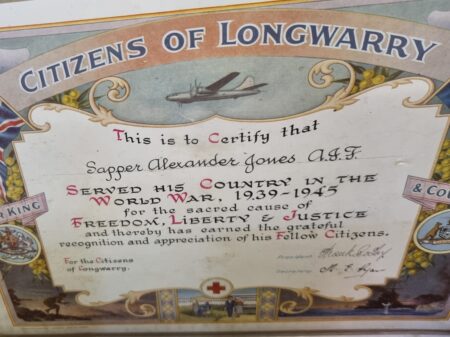
Example of certificate
The First President of the RSL was Cr J H Smethurst, a local Councilor. (He held the position until a General meeting could be convened).
6th June 1918 The Gippsland Independent, Buln Buln, Warragul, Berwick, Poowong & Jeetho Shire Advocate reported:
The Longwarry Soldiers Memorial League held its first annual meeting. Mr G A Smith was elected President, with Cr Smethurst standing down.
Balance sheet showed profit for the year of 181 pounds.
The Memorial Monument
In 1919:
“The Longwarry Soldiers Memorial League applied to the Buln Buln Shire Council at its meeting on 7th July 1919 for permission to remove a tree on the site of the proposed memorial. Permission was granted.”
Later that year
“The Longwarry Soldiers Memorial League applied to the Buln-Buln Shire Council at its meeting on 6th October 1919 for a Public holiday to be declared on 12th November 1919. Requested permission to erect poles for decorations, and to direct traffic through the railway yard. These requests were agreed to.”
25th November 1919. West Gippsland Gazette reported:
Granite Monument in Honor of Longwarry Soldiers unveiled on 12th November.
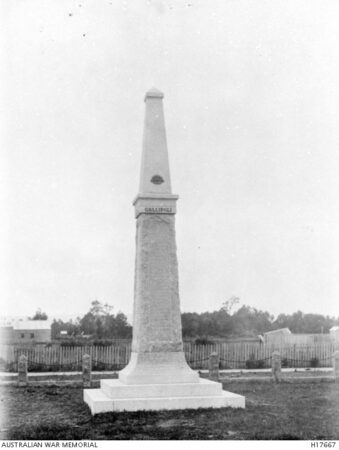
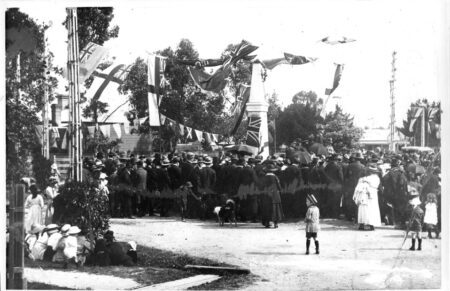
“A crowd of approximately 2000 saw the unveiling of the memorial erected by the residents to perpetuate the memory of those brave boys who had enlisted from the district.”
The dedication ceremony on 12th November 1919 was conducted by Captain Stanley Bruce, the local Federal Member of Parliament, who later became the eighth Prime Minister of Australia.
The names of 119 heroes from Longwarry were inscribed on the monument. A project initiated by the Longwarry History Group, with students from Labertouche and Longwarry schools, to commemorate the centenary of the Armistice in 2018, found that another name should be added to the memorial.
Research was presented to the RSL Sub-Branch and it was accepted that the name of Nurse Mary Kennedy, who was born in Longwarry, should be added. A grant was obtained from RSL Victoria and her name was unveiled on 11th November 2019 at a rededication of the memorial on its 100th anniversary. Returned service personnel from subsequent conflicts were remembered via plaques attached to the bottom step in later years.
The memorial remained in place until it was suggested in RSL minutes in 1969 that:
“Mr Gardner asked what were the members view on the removal of the Memorial to a new site, and it was agreed that the time had come for expansion of the roadway, to cope with the growing traffic through the town.”
The search for a new site began. A meeting in September 1977 mentions the railway’s refusal to have the memorial placed on railway property. It was then moved that the Buln Buln Shire be contacted and accept the H G Toy Memorial Park proposal as the position seems the best available. It seems that a new home had been found for the Memorial Stone. However, the next meeting indicates that the RSL accept the Education Department offer (the local Principal was a Sub-branch member) of their piece of land for the relocation of the War Monument. Was this the final resting place for the stone? Later that year, a mention in a meeting suggested that the RSL contact the Shire regarding the completion of the fence around the War Monument and also the school fence. The Monument had found a home adjacent to the local Primary School, but it wasn’t to be its last move.
The monument was attacked by vandals in 1984. The responsible people were caught and charged. The RSL was concerned for the lettering on the monument and how they would fix it. Two cheques from the Warragul Clerk of Courts amounting to $490 were gratefully received by the RSL and was used to have the memorial returned to its original state.
The moving of the memorial stone was top of the agenda in 1998. A meeting in October of that year reads:
“that thought be given to relocating the monument to Bennett Park.”
In November 1998, correspondence was received from Baw Baw Shire re the suggestion to move the monument to Bennett Park. The Shire answered that” they were unable to assist with the moving, but agreed the suggestion has merit.”
In December of that year a minute of a meeting outlines that contact should be made with the Dept of Army Engineering regarding plans to move the monument.
The monument was moved to its present position and consecrated on 15th October 2000.
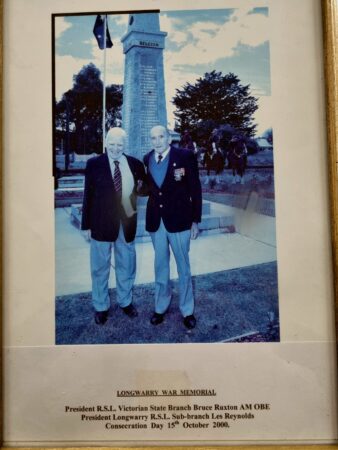
Bruce Ruxton AM OBE President Victorian RSL with Les Reynolds President Longwarry Sub-Branch, Consecration Day 15th October 2000.
Bronze plaques in memoriam of WW11, Korea and Vietnam were then added.
The seat at the monument was initially proposed by the Ladies Auxiliary. It was delivered and installed in 1998. The seat was a donation from Baw Baw Shire.
The Early Years
During the years 1919 to 1946, not a lot is known about the RSL in Longwarry. It’s generally believed that meetings were held, but no “official” records remain. Consensus has it that the records (if any) perished in the Hall fire in 1951, therefore depriving future generations of any solid facts. The “reforming” of the Branch in subsequent years suggest strongly that the RSL was active for at least part of this time (1921 – 1946).
Happily, minute books still exist from 1946 onward.
New Sub-Branch First Meeting:
25th June 1946 saw a meeting held in the Longwarry Mechanics Institute, attended by 21 people.
Cr Pretty, Mr W Boyes, Mr L Couacaud, Mr H Andrews, Mr F G Pope, Mr H Hill, Mr B Tolley, Mr W Mills, Mr A G Tilbury, Mr S H Eacott, Mr W W MacGillivary, Mr HR Toy, Mr W Murnane, Mr C A Ford, Mr H Dore, Mr J Mills, Mr S J Serong, Mr E S Murray, Mr W C Dixon, Mr E S Wenn Mr F C Wade
These foundation members were likely all returned from the war theatre and would be the core of the local RSL for many years to come.
Minutes from this meeting read:
“At the outset the meeting was addressed by Cr Pretty and Mr W Boyes both strongly advising that the Longwarry Sub-Branch of the RSL be re-formed.”
“Moved by Mr W Mills, Seconded by H Hill that the Longwarry Sub-Branch of the RSL be re-formed.”
And so the reformation of the RSL and the inception of the Sub-Branch began.
Elections took place with the following Officers appointed:
President – Mr F C Pope (DFC)
Senior Vice President – Mr H Murnare.
Vice President – Mr WW MacGillivary
Treasurer E S Wenn.
Secretary Mr H Toy.
Additional Committees were formed, bank accounts were to be opened and the Longwarry RSL Sub-Branch was up and running……again. Membership was strong and meetings were well attended. The branch was included in the 39th District, however it transferred to the 44th District a few years later. This meeting was the first in the reformation of the Longwarry Sub-Branch.
A minute from a subsequent meeting conveys:
“Moved by W K Steinholt, seconded by W E P Murray that 8 members constituted a quorum. Carried unanimously.” …. This will be tested in the coming years when attendances were low.
The business of the RSL continued smoothly during the 1940’s with meeting attendances high and work continuing in the community. Poppies were sold on both Armistice Day and Anzac Day, with proceeds going to returned service personnel as it had from the earliest years. As well as assisting returned service personnel, the RSL never lost track of the original “mateship” ethics on which it was formed. To this end, members who were taken ill, were sent gifts from the RSL. There are many mentions of ex personnel and members being in Heidelberg Repatriation Hospital and Warragul Hospital. These men were sent gifts from the RSL to lift their spirits. One hamper sent to a member in hospital consisted of “fruit, chocolates and cigarettes”, an odd choice by today’s standards.
Additionally, gifts to Legacy were quite common. The Branch also sent funds collected from Anzac Day poppy sales to the “Food for Britain Fund,” a charity set up to feed the returning service personnel in Britain, until it got back on its feet agriculturally.
Many war Widows were helped by the RSL, again consistent with the core values. This may have been through Legacy donations, or indeed direct donations to Widows. Again, the minutes show examples of these direct donations. Other organizations were recipients of donations from the RSL.
Meanwhile the RSL again continued its work. Once the Second World War was over, the RSL were quick to honor fallen comrades. The monument was to be updated to reflect the lives lost in WW11:
Meeting minute 15.11.1948 (Meeting book shows as 15.12.1948)
“On the Motion of E S Murray, sec L Addison that a subcommittee of three be appointed to investigate and check names on the Longwarry Monument Stone, and further names of fallen comrades in 1939 – 45 war to be engraved on the Longwarry Stone. Committee with a quote from Mr C Skewes (Monumental Engraver) to count names and letters and work out approximate cost to place before a public meeting, when called.”
The upgrading of the monument was to take longer than originally envisaged. Numerous sub-committees were formed to investigate the upgrade and finally on 29th June 1950, a minute shows that:
“Mr A Burton should call a public meeting in an endeavor to interest the public generally in financing additions and renovations to existing memorial or some other alternative.”
Since then, plaques have been added to the memorial relating to conflicts in WW11, Korea, and Vietnam.
In 1969 the first mention of placing Memorial gates and ticket box at the Recreation Ground is minuted.
The Memorial gates were mentioned again in September 1968. The RSL asked the Ladies Auxiliary to attend a meeting to discuss ways of raising money for the erection of the gates.
A number of different events were held, including a variety night, plus numerous raffles by both the RSL and the Ladies Auxiliary.
Eventually it was decided there were to be two gates to be “8ft and 4ft wide x 3ft.6” high on each side of a newly built ticket box. The gates were to be in the “GJ 30 style.”
Fundraising continued into the 1970’s with an Easter egg raffle, with all proceeds towards the gate fund.
Finally in April 1970, a motion was carried to accept a tender for the building of the gates and ticket box. The opening of the new gates was to be in January to coincide with “the carnival.”
Many working bees were run to paint the gates and the ticket box and also to lay the road around the gates. The Ladies Auxiliary donated $200 to the “gate fund”, an enormous amount for that time. The RSL was extremely grateful to the ladies for all their hard work raising these funds. The gates and ticket box were finally finished in 1971. The gates were badly damaged in 1975 by “someone running into them” two months in a row. A letter was sent to the Recreation Committee regarding this. The reply indicated that the Recreation Committee “knew who it was” and legal proceedings were underway to cover the cost of repairs. Additionally, a caretaker was to be appointed who would live on the grounds. All was well after this and the gates and ticket box were left unscathed.
Sadly not much is left of the gates, the whereabouts are unknown. The ticket box remains, along with the pillar which housed one of the gates.
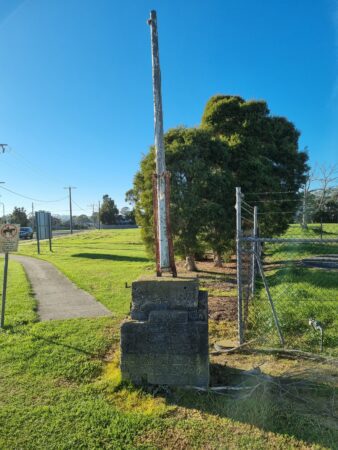
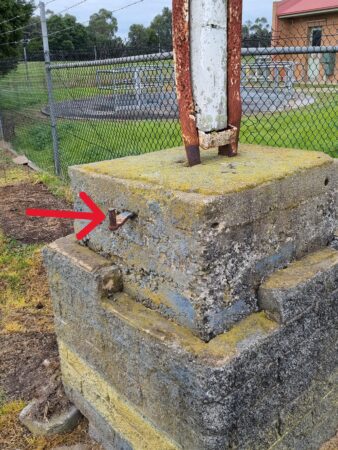
The memorial gate pillar. A close inspection reveals a hinge on the front which supported the gate.
Patriotic Fund
Patriotic funds are a type of trust fund created after the First World War, when Victorian communities raised money to assist soldiers and their families. They provide welfare services and clubrooms for returned service personnel and their dependents. (Source Consumer Affairs Victoria).
On 14th February 1955, a minute from that meeting indicates that Longwarry Sub-Branch should obtain a Patriotic Fund number to enable the Branch to obtain a portion of the proceeds from the “Poppy Day” appeal.
The Longwarry Sub-Branch R.S.S.A.I.L.A. Welfare Patriotic Fund received their authority to set up the Patriotic Fund in 1955.
The establishment of the Patriotic Fund was an important step for the Longwarry RSL. Without it, no funds, subscriptions or donations related to any military service could be collected.
It was suggested that the Patriotic Fund should be wound up in September 1976 with the amount remaining being donated to the Central Legacy Group.
A minute in the following month shows that the fund was to be kept, with new trustees appointed.
New Club rooms
During the late 1940’s the first indication of “stand alone” clubrooms was mentioned. Between the years 1947 and 1951, the Branch was actively looking to establish their own club rooms.
Meeting minute 20.8.1947
“Club rooms for our own Sub-Branch. After an interesting discussion during which all present showed keenness for the idea, it was moved by L Addison, Sec M Wade, that at our next meeting the subject should be more fully discussed. Meanwhile write to Mr L J Martin regarding the possibility of purchasing a suitable block of land.”
It is assumed Mr L J Martin was a wealthy landowner from the district and a generous entrepreneur of the time.
Meeting minute 17.9.1947
“A letter sent to a Mr L J Martin requesting to buy a piece of land opposite the Longwarry Railway station, was answered by Mr Martin with the offer of the piece of land as a “gift” to the RSL. A motion was then carried to erect a suitable building on this site for the Club rooms.”
Later meetings show no reference to this piece of land ever being used for that purpose. It’s believed this piece of land is near the railway station, next door to where the old Commercial Hotel stood before burning down in 1926, or perhaps it was the land where the hotel stood.
Later, minutes of a meeting on 13th September 1965 show that members voted to sell “the RSL’s block of land for 275 pounds.” It’s not mentioned whether this is the above block. We can only speculate. It is later mentioned on 9th May 1966 that the block sold for $500 and the funds were to be placed in a fixed term deposit with the local bank. These funds would remain in the bank over the years and in 1982 earned a staggering 15% interest.
The subject of stand-alone Club rooms was never far from the thoughts of the members.
Meeting minute 20.10.1948
“Motion of A E Burton, Sec W McGilvaray that Secretary M Wade make enquiries as to approximate cost of a building 50 x 25, of cement sheet, tin roof to be used as new club rooms.”
Perhaps these enquiries related to the above piece of land, but subsequent events suggest it may not, as later 1948 minutes reveal a separate piece of land was being sourced.
Meeting minutes 15.12.1948
“At this stage of the meeting, much discussion took place as to obtaining a suitable piece of land to erect the RSL Clubrooms and on the motion W MacGillivary, sec C A Ford, that a letter be written to Shire Council asking for a grant of a piece of land off the hall grounds, at the South end.”
It’s unknown where this piece of land was, or if it ever made its way into the hands of the RSL, but subsequent events suggest it didn’t. This piece of land may have been where the addition to the current hall stands today, but this can’t be verified.
In 1950 the Hall was closed for public functions by the Health Authorities. This left the RSL with no hall in which to hold smoke nights or other fundraisers and as such numbers began to diminish. Meetings were poorly attended. There are numerous mentions in minutes that:
“Letters be sent to all Members to attend as many meetings as possible”.
(Longwarry’s Old Hall Destroyed 10 April 1951 – The Age Melbourne)
The RSL used the Mechanics Institute (Hall) for their meetings from 1946 until it burnt down in 1951 and with it, presumably the missing history of the local RSL branch.
The last meeting in the “old hall” was 19th March 1951. The next meeting was held in the Bank chambers on 16th July 1951 with a motion carried that:
“Until a new hall was built, meetings would be held quarterly”.
The decision was made to hold meetings quarterly owing to the lack of suitable rooms for the purpose. The Bank Chambers were used as a stop-gap solution while the Hall was being rebuilt. Numbers dropped considerably during this period, with the President again appealing to all members to attend the meetings. Letters were sent to all members to encourage them to renew their “subscription”.
A new hall was to be built and the RSL hoped to use it for future meetings.
There was a pause in meetings (Sept 1952 – Nov 1953) as no suitable rooms were available. The meetings resumed at the Bank Chamber in November 1953 with a minute suggesting:
“We endeavor to return the branch, after a lapse of 12 months due to the inability to find suitable rooms.”
A motion was passed in July 1952 to donate 100 pounds to the Longwarry Hall Committee to help towards the building of a new Hall. The new hall opened in 1953.
(New Hall at Longwarry 10 July 1953 – The Argus- Melbourne)
November 1953 saw the first meeting in the new hall. During this meeting there was discussion around the Annual Ball. It was decided that 50% of proceeds from the ball be donated to the Longwarry Hall committee. Later meetings show the RSL donating money to the hall to buy such things as tables and chairs, no doubt in thanks for the use of the hall.
By now numbers at meetings had dropped even further, with as few as seven or eight attending. Again, the President advised sending letters to all members to remind them of the importance of attending meetings.
The first mention of “adding on” to the new hall appeared in September 1959. It seems the efforts to have stand-alone club rooms on the South side of the new hall had failed and members voted to attend hall meetings to draw up plans for club rooms to be added on the North side of the hall where it stands today.
The first meeting in the new club rooms was 12th September 1960. Attendance was at a nine year high, with 20 members present for the occasion. At this meeting it was decided to have the opening on 12th December. Robust discussion ensued regarding invitations for the event. Some members (whose names don’t regularly appear at meetings) moved to invite “outside people” who had helped with the building. Two members moved an amendment to have “no outsiders” in attendance. A vote was taken and the amendment defeated, allowing “outsiders” to attend.
The new rooms were officially handed over in December of that year. The “Grand Opening” was marked with a supper in the “Buffet style”.
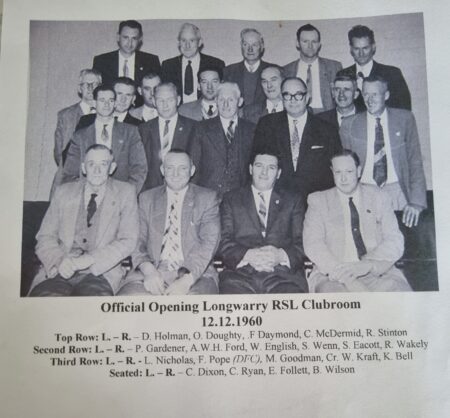
Official Opening – Longwarry RSL Club Rooms 12th December 1960
The rooms have been used by a variety of groups over the years. The Ladies Auxiliary, Meals on Wheels, The CWA the Local Senior Citizens and others were allowed “free use” of the rooms. Minutes show that on at least one occasion, Meals on Wheels sent funds to the RSL thanking them for the rooms use. Other groups such as the Factory Social Club and the Football Club were charged a small fee for the use.
In 1982 it was suggested that a door be placed connecting the RSL rooms to the Main Hall and toilets “as some elderly citizens find it inconvenient when it rains”. The door and steps were to be installed at no cost to the RSL and hopefully the cost be borne by Buln Buln Shire. However, minutes of 8th August 1983 show that: “we hold a raffle to raise funds to help towards the placing of a door between the hall and the RSL rooms so as the use of the inside toilets be used for the people who use our rooms. It’s to be a combined effort with the Senior Citizens.”
In December that year, a meeting minute rescinds the motion of January 1983 regarding floor coverings in the rooms. These earlier minutes point to the RSL wanting to cover the floors with carpet or vinyl. The December meeting decides to write to the Hall Committee” complaining about the way the RSL rooms floods during heavy rain, as the runoff from the hall is not adequate to cope with the flow.” The floor coverings were put on hold. The next meeting suggests that the floor coverings be at no cost to the RSL, with Shire approval.
Anzac Day
Due to the closeness to Melbourne, it was decided very early in the Branch’s history, to hold the local Anzac Day service on the closest Sunday prior to 25th April to allow ex service personnel to travel to Melbourne to participate in the much larger march. Occasionally the Anzac Day service was held after the 25th, depending on the availability of members and the proximity to Anzac Day. This tradition is still upheld to this day. Indications are that the commemorations at the monument attracted good crowds, with sales of poppies increasing year on year. The Salvation Army Band from Warragul was a constant performer on Anzac Day for many years, as was the Salvation Army Band from Morwell, and was most appreciated by the RSL members. Local Boy Scouts and Girl Guides were regular attendees at the Anzac service, as well as representatives from the local school. Later the band from Pakenham was invited to play at the Anzac Day service. It was quite common for the Shire President, or a ranking officer from RSL Headquarters to speak at the service and lay a wreath.
There has always been a service for Anzac Day, but in 1965 the service was cancelled “owing to unforeseen circumstances, arising from Easter Sunday church services.” This may be the only time since the first war that the Anzac service was not held. In subsequent years, if Anzac Day fell on Easter Sunday, the Anzac service was moved to accommodate the church services.
Armistice Day (Remembrance Day)
Poppies have always been a part of the RSL’s commitment to Armistice Day. Money raised from the poppies sales are used to support Veterans and their families in the district.
The RSL used to sell “car stickers” for Armistice Day, presumably for locals to show support, by attaching the sticker to their motor car. Not many of these were ordered by the RSL, presumably due to the low amount of vehicles in the district.
During the 1980’s representatives of the RSL visited the local school giving talks on the significance of Armistice Day to the children.
Interestingly, in days past, a representative would “set up camp” outside the local milk bar to sell poppies for Armistice Day and Anzac Day This tradition lives on today, with the RSL still selling poppies and badges outside a local café, as well as using the local market as an outlet for sales. Not a lot has changed. Their forefathers would be proud.
Social Occasions
The Longwarry RSL was a very social Branch. Numerous “smoke nights” were held throughout the year, predominately to raise funds, but also to keep the work of the RSL foremost in the public mind. Additionally euchre tournaments were very popular and an important part of the fund raising activities.
The funds were used to cover the costs of poppies and car stickers for Anzac Day and Armistice Day, as well as providing relief for returned soldiers experiencing tough times. Funds were also
used to cover the costs of the Ladies who spent considerable time and money catering for these events.
Annual Balls were held in the Hall, usually in November. The RSL would sponsor the “Belle of The Ball” (with a prize of a canteen of cutlery or suchlike). The Belle of the Ball was a most sought-after award, with many young women of the district vying for the honour. The recipient of the award was usually presented to a high ranking officer in the RSL, or a local MP. Later this was extended to include “Beau of The Ball”. There is no prize mentioned for being crowned Beau, most likely it was a prestigious title just to be named alongside the Belle.
In addition to the Annual Balls, dances were held in the hall from time to time to raise funds to cover those expenses previously mentioned. These were well attended soirees and were very profitable for the RSL.
The ethos of the RSL to support returning soldiers continued post WW11. Many “Smoke Nights” and other gatherings are mentioned in minutes during the 1940’s and evidenced with Welcome Home banquets for returning service personnel.
Cricket and Football matches were quite common during the 1940’s and 50’s. These events were played by the RSL against teams from “The Factory”, or other branches in the district ie Bunyip.
Collection plates were placed around to garner extra funds for the RSL’s work.
Equipment was purchased by the RSL for these occasions.
In 1961, a member (Mr R Stinton) was commended for “the good job he had done on the table tennis table.” It’s assumed the member constructed the table and it was to be used by members for recreation purposes. Minutes later that year show that the RSL hired out the table to the community to help raise funds.
Monthly Meetings
Most meetings of the RSL were long affairs, many finishing late in the evening (10 pm was not uncommon). This was sometimes followed by a recreational game of cards and “refreshments”.
During the Clubs reformation in the 1940’s, meetings were well attended with 20 plus attendees, not uncommon. Actual membership numbers are unknown, but it’s assumed that most members attended the meetings. These numbers began to dwindle, likely due to some members passing away, or indeed moving away from the district to retire.
Meetings always began with members standing and observing a minute’s silence in memory of fallen Comrades.
Many issues were discussed during these meetings. The work of the Women’s Auxiliary is mentioned many times and is not to be overlooked in the history of the RSL. In addition, the granting of funds to members who had fallen on hard times were passed. Committees were appointed for such things as The Annual Dance, Armistice Day and Anzac Day. These committees had a wide inclusion of members, showing the spirit that “many hands make light work”. Records show that all members contributed to the discussions, until a consensus was reached.
The December meetings were usually a “social night” with cards and Christmas goodwill to the fore. Many meetings featured “slide nights” with members bringing in slides or pictures of recent holidays to share with the members.
The RSL was very involved with the TPI pension payments, and this topic was brough up many times over the years. There are numerous mentions of letters being sent to local MP’s regarding the amount of the TPI payment, and to ensure all returned service personnel were receiving their allowance. The RSL also gave time and money to widows for anything deemed appropriate. There are mentions of the RSL giving funds to cover house plumbing, leaking roofs, and even trips back to Scotland for Mrs Pope.
Attendances at meetings increased during the 1960’s. A push in the late 50’s by former President Mr A Burton to contact all members and returned service personnel in the district and remind them about the job the RSL does. This membership drive appeared to be a success, with the Longwarry Sub-Branch receiving recognition from the Victorian State Council of the RSL for increasing membership numbers during 1958.
During the 1970’s membership was on the decline again. Many mentions of ways to increase the membership appear in the minutes, but meetings were being attended by only eight or nine people, but at times as few as five. However, the work of the Branch continued. It was around this time that Melbourne Cup sweeps were sold by the Branch to raise funds. With a first prize of $100, these sweeps were very popular and continued for many years.
November 1983 saw no meeting of the RSL due to damage from a “hurricane”, flooding and power blackouts.
During the mid 1980’s, meeting attendances were between seven to ten people. Membership numbers are unknown, but there is no reference to any membership “push”. The RSL continued raising funds and the Ladies Auxiliary was again, particularly active in this respect, with numerous donations between $100 and $300 seen in minutes. The RSL also raised funds by “hiring out” the club rooms to the Elderly Citizens and billing the Shire for the cost. $300 and later $350 per year was to be charged and the minutes indicate the payments made by the Shire.
1988 saw the erection of the flagpole at the Memorial Stone.
During this time, some members seemed to have been none too pleased with some real estate transactions. Minutes of a meeting in June 1988 read:
“It was moved that we write to Mr Cunningham (local member) protesting about the Japanese taking over the purchase of a lot of Australian property.”
In 1989 there is mention of whether the Longwarry RSL Sub-Branch should have a set of Constitution rules and be incorporated. This was agreed in February 1990, and the incorporation process began.
Meeting attendances were very low during the early 1990’s, with some meetings only attracting four members. But the RSL continued to donate funds to The Red Shield Appeal, Legacy and other deserving charities.
1991 shows the beginning of the work to have the long-standing Secretary Mr C “Occa” Ryan receive the RSL Certificate of Merit, with gold badge. The In Memoriam board was also moved into the club rooms this year.
1993 saw a push for membership begin. A notice was placed in the local newsletter reminding members of monthly meetings and to invite all ex-service men to join the RSL.
There have been many gifts to the RSL over the years. Medals and awards were kept in the club rooms in cupboards, sometimes made expressly for that purpose. At other times these gifts were simply mounted in full view.
One minute from March 1976 shows that:
“Our President K Bell donated a rifle (303), bayonet and tin hat to our club rooms, and duly mounted them.”
Mystery surrounds their whereabouts today.
The RSL in the Community
In 1980 the RSL held a public meeting in the rooms to help raise funds for a “jaws of life” presumably for the local Emergency Service or CFA. Over $1000 was raised for this, with the assistance of the Ladies Auxiliary combined with other local bodies such as the Progress Association and the local school.
In 1983 the RSL was on the front foot regarding the “Tidy Towns Competition” for that year. A letter was sent to the Buln Buln Shire asking what the RSL could do to promote Longwarry in the competition. Delegates were sent to the progress meeting in July to see how the RSL could help. Working bees were attended by RSL members (and their families) prior to judging day.
During 1996 the RSL began a grant to the local Primary School of $100 for the purpose of a Boy and Girl scholarship, to be on-going. Minutes show “this was designed to bring school children closer to the RSL and may help with token and poppy sales, as well as give children a better perspective of RSL activities, and why we have meetings to remember our fallen comrades.”
Meetings switched to afternoons during the late 1990’s. Attendances were slightly up and the RSL had a healthy balance sheet. The painting of the club rooms is mentioned a few times, as well as the window coverings. The Senior Citizens group agreed to install vertical blinds, so the RSL set about having the rooms painted. This arrangement suited both parties apparently, as there is no further mention of the rooms being “hired” to the Senior Citizens. The stone memorial was to be “updated” at this time, though there seemed to be confusion on who owned the land it stood on. Apparently, if it was Council land, then a grant was available, if not then the RSL would have to bear the costs. A quote was received for $2,600 and sent to the Shire. This work was to update the monument only and didn’t include the bronze plaques which are now attached. The plaques were mentioned in June 1998 in regard to getting a quote to have them added to the monument piers.
The Bofors Gun
The Bofors gun was first mentioned in August 1974. The price of $35 was agreed as long as the RSL paid for the transport costs. Part of the cost of the gun was borne by the Ladies Auxiliary, as well as other locals. The gun arrived in Longwarry about September 1974. The RSL wanted it to be part of a memorial. The railways owned the land which was proposed for the gun. Because of this, the gun was handed over to the Longwarry Progress Association in April 1975. A minute shows the reason for this:
“as the railways do not allow us to put it up as a memorial piece on land owned by them.”
And so, the gun was placed on land not owned by the railways, but on Shire land, out of the control of the RSL. The RSL was not entirely happy with this result, however the gun was now in town and would stand as a monument to returned service personnel.
In July 1992 The Shire approached the RSL seeking permission to relocate the gun in the park, to a spot adjacent to the Fire Brigade. It seems ownership of the gun had transferred back to the RSL. The reason for the relocation was to build a toilet block in the park, so the gun was moved to a space opposite the Longwarry Hotel, where it stands today.
There have been many Presidents over the years, some serving multiple times, others simply a year or two.
Presidents
1946 -1947 Mr F C Pope (DFC)
1947 – 1950 Mr E S Wenn
1951 – 1954 Mr A W H Ford
1955 – 1959 Mr S Burton
1960–1961 Mr E Follett
1962 – 1963 Mr C McDermid
1964 – 1965 Mr K Bell
1966 – 1967 Mr B Wilson
1968 Mr B Wilson & Mr D Holman
1969 – 1970 Mr D Holman
1971 – 1976 Mr K Bell
1977 – 1979 Mr J Rogers
1980 – 1981 Mr D Holman
1982 – 1985 Mr K Bell
1986 – 1987 Mr R Arnett
1988 Mr D Holman
1989 – 1990 Mr L Reynolds
1991 – 1993 Mr P Bawden
1994 – 1996 Mr D Holman
1997 – 1999 Mr L Reynold
In addition to the Presidents of the RSL, special mention should go to Mr C Ryan, who served as Secretary of the Longwarry RSL from 1954 – 1985, a total of 31 continuous years. He was made a life member of the RSL in 1977.
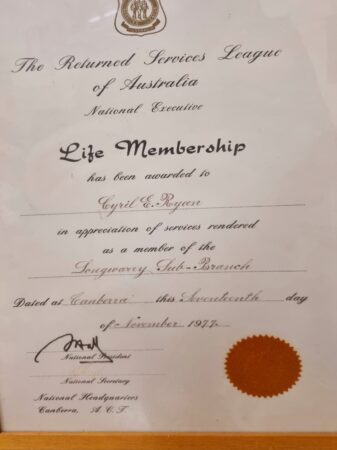
In 1976 Mr K Bell was appointed President of the 44th District Board.
In 1986, former President Mr D Holman was nominated for The Anzac Award for services to the CFA and the RSL over 40 years. The award was bestowed on him early in 1987.
Mr A Tilbury (Former President) was made a life member of the Sub-Branch in May 1986.
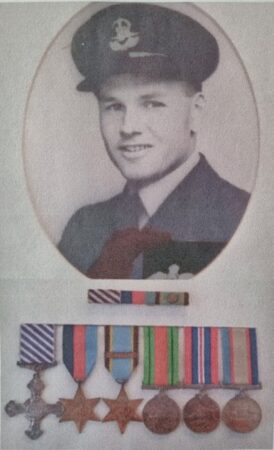
Mr F C Pope (DFC)
Probably Longwarry’s most decorated soldier.
First President of the “re-formed” RSL 1946 – 1947
(Source National Archives of Australia)
The Ladies Auxiliary
The 13th February 1961 saw the first mention of the formation of a Ladies Auxiliary. The Auxiliary was formed to co-exist with the RSL and assist in the work they did in the district. Additionally, the RSL relied on the Ladies Auxiliary for help with catering for functions and assistance with public outings which were arranged in conjunction with each other. The auxiliary were also responsible for arranging Christmas parties for the RSL members and families.
While details of the original auxiliary are scant, many of the women who formed the Ladies Auxiliary were wives of members of the RSL, so had a good understanding of how the RSL operated, and what they could bring to enhance the RSL operations.
During the late 1960’s RSL minutes indicate low numbers at the Ladies Auxiliary, and a number of goodwill gestures seem to be made to the ladies to help boost their numbers. Members voted to assist the Ladies with fund raising and boosting of membership numbers. The RSL showed their appreciation for the work done by the Ladies Auxiliary by hosting a night out for them and their partners (partners to pay separately) every year at a hotel in Pakenham.
Apparently, the Ladies Auxiliary were quite good at raising funds, (there are many examples of donations of $100 and $200 to the RSL in the minutes) and were curious to see where the money was going. A minute from the RSL meeting on 12th April 1976 shows:
“The RSL sympathizes with the Ladies Auxiliary in the way they raise large sums of money, for the Sub-Branch, but have no say in what they do with the money, but the rules are laid down by Headquarters to protect the Sub-Branch against anyone using the funds outside the jurisdiction of the Sub-Branch.”
Surnames such as Ford, Serong, Ryan, Bell and McDermid were very active in both the RSL, and the Ladies Auxiliary. Membership in the early years was strong. Records show that in the 1990’s meetings were attended by 15 – 20 ladies. The Ladies usually met in the RSL club rooms, with fundraising the top subject. In the 1990’s the ladies put together hampers and raffled them off. Funds raised were usually sent to the RSL or to Legacy. The hard work of the auxiliary can’t be stressed strongly enough when participation with the Sub-Branch was concerned.
Membership numbers dropped significantly in the late 1990’s, mostly due to the passing of long-term members, and a downturn in the number of ladies interested in the auxiliar.
Sadly, the Ladies Auxiliary disbanded on 31st July 2010. A minute of the final meeting indicates:
“After much soul searching and concerted efforts to boost our numbers, it has been decided that as an auxiliary we can no longer keep going with the number we have. This decision was made with much regret, but with a resolve to support our Sub-Branch as affiliated members and continue raising funds for our service members in this way, into the future”.
The “In Memoriam” board was purchased and hung in the Club rooms in June 1962. It was decided that inscriptions for this board begin from 1939 onward. The first inscriptions were made in July 1962. The board was moved to the club rooms in 1991.
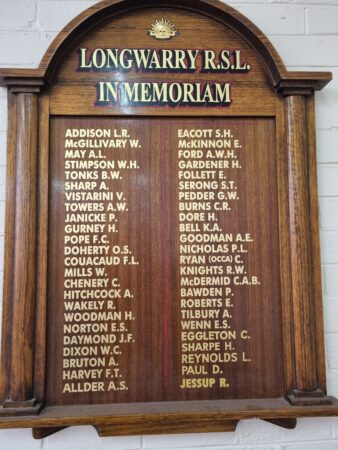
An additional board now hangs in the RSL club rooms.
The 50th anniversary in 1996 was celebrated with dinner at “the local hotel”. Sadly attendances at meetings were extremely low at this stage, and the anniversary was passed with a somewhat small gathering. A commemoration certificate is still in the RSL rooms today.
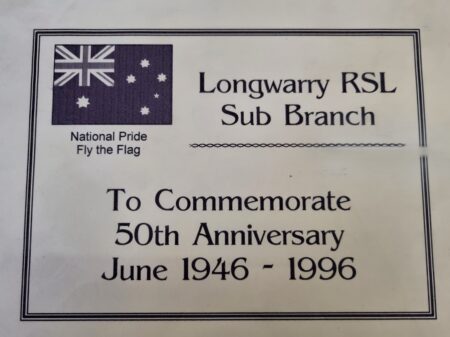
Copy of the Certificate commemorating 50 years of the Longwarry RSL Sub-Branch
Today the Longwarry RSL still operates with the same ideals from its inception, unchanged for over 100 years, that being:
To support those returned service personnel who have fallen on hard times, in the name of mate ship.
A great debt is owed to the “original” founders of the Longwarry Sub-Branch in 1917, and to those 21 men who re-formed the branch that evening in 1946. The amount of money raised, and the lives helped can never accurately be established, but a great many families are grateful for the help they received over the years from the Longwarry RSL Sub-Branch.
Sources:
National Archives of Australia
The Gippsland Independent
Buln Buln, Warragul, Berwick, Poowong & Jeetho Shire Advocate
The Argus, Melbourne
The Age, Melbourne
The generosity of the Longwarry RSL Sub-Branch for supplying minute books and allowing photographs of various documents in the current club rooms.
Many of the quotes contained herein are directly from minutes of meetings. Any errors or omissions are entirely that of the Author.
They shall grow not old, as we that are left grow old:
Age shall not weary them, nor the years condemn.
At the going down of the sun and in the morning
We will remember them.


Comments